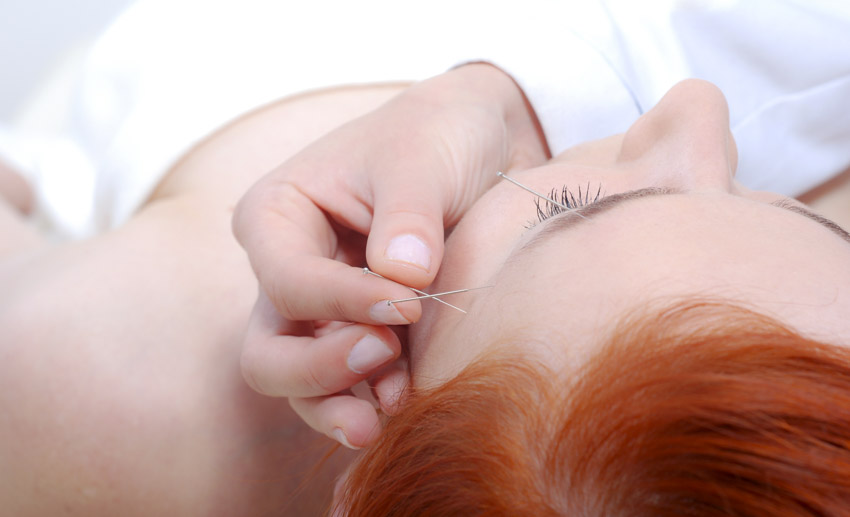Researchers find acupuncture effective for the prevention and alleviation of migraine attacks. Migraines are the source of intense pain, lasting for hours or days. Chronic migraine sufferers may experience nausea, vomiting, and hypersensitivities-making them prone to anxiety and depression. Research conducted at the 254th Hospital of the Chinese People's Liberation Army demonstrates that electroacupuncture therapy in the projection zone and conventional acupuncture are both effective protocols for the elimination of migraine attacks.
A total of 120 migraine patients, between ages 18–70, were randomly divided into four groups:
Projection zone group
Patients were treated with electroacupuncture by licensed acupuncturists in the projection zone area-from Yuzhen (BL9) to Tianshu (ST25)-using 0.30 mm × 50 mm Hwato brand acupuncture needles (Suzhou Medical Supplies Co., Ltd.). Four equidistant needles were applied along the BL9 to ST25 line, until patients experienced deqi sensations (e.g., soreness, numbness, heaviness). A Han's Acupoint Nerve Stimulator (HANS) with a 2/100 Hz alternating frequency at 8–20 mA was applied to BL9–ST25. The 30 minute treatment was administered once per day, over the course of 10 consecutive days.
Conventional acupuncture group
Acupuncture therapy was applied to the following acupoints and were manipulated to achieve a deqi response:
Taiyang (MHN9)
Lougu (SP7)
Xuanlu (GB5)
Touwei (ST8)
Fengchi (GB20)
Waiguan (TB5)
Taichong (LV3)
Zulinqi (GB41)

Next, electroacupuncture with the HANS device using identical electroacupuncture settings as the projection zone group was applied (8-20 mA, 2/100 Hz, 30 minutes). Daily treatment was similarly administered over 10 consecutive days.
Non-acupoint group
Patients were treated over 10 days with four equidistant needles applied 2 inches away from the Yuzhen (BL9)/Tianzhu (BL10) line, until deqi sensations were induced. This was also followed by the use of the HANS device with the same electroacupuncture settings (8-20 mA, 2/100 Hz, 30 minutes) as the projection zone group.
Drug group
Diclofenac sodium enteric-coated tablets were administered orally, twice per day, 50 mg per dose, over the course of 10 days. Diclofenac sodium is a nonsteroidal anti-inflammatory drug (NSAID).
Exclusion criteria were established. Patients with the following conditions were not admitted to the study:
-- blood disease
-- heart disease
-- liver disease
-- kidney damage
-- brain trauma
-- brain tumor
-- epilepsy
-- high blood pressure
-- mental illness
-- infectious diseases
Pregnant or lactating women were excluded from the study. In addition, patients taking migraine medications or with basilar migraines were excluded. Scores were taken before and after treatment for the comparison and analysis of the therapeutic effects. The study evaluated the therapeutic effects of the four groups using the following four types of rating methods:
Visual Analogue Scale (VAS) scores: a value based on the scale of pain
TCM syndrome scores: a value based on the frequency, intensity, duration, and associated symptoms of headaches
-- Self-rating anxiety scale scores (SAS)
-- Self-rating depression scale scores (SDS)
Results
The total effective rate of the therapy in the projection zone group (93.33%) was higher than that of the conventional acupuncture group (86.67%), drug group (70.00%), and non-acupoint group (63.33%), with statistical significance (P=0.004). Pre-treatment VAS scores and TCM syndrome scores in all four groups improved significantly (P<0.05) after treatment. Post-treatment VAS scores in the projection zone acupuncture group were significantly better than the other three groups, and their TCM syndrome scores were also significantly better than the drug group and non-acupoint group (P<0.05). SDS scores in all four groups also improved significantly, with statistical significance (P<0.05). Post-treatment SAS and SDS scores in the projection zone group were significantly better than the other three groups (P<0.05).
The researchers conclude that acupuncture successfully alleviates migraines and reduces associated anxiety and depression. Electroacupuncture in the projection zone outperformed all other groups in the investigation.
References
Xiao L, Wang Y, Wang S, Wang LX, Cui Q, Zhang C, Yao LH, Shao JY, Xing J. Clinical Study on electroacupuncture Treatment of Migraine in Surface Projection Zone of the Pyramid Decussation [J]Chinese Journal of Information on TCM, 2018 (01).
Xiao L, Cui Q, Zhang QJ et. al, Study on the Therapeutic Effect of electroacupuncture on 60 Cases of Migraine [J]. People's Liberation Army Medical Journal 2013,25(7): 61-64.
Zhao L, Chen J, Li Y et. al, The Long-term Effect of Acupuncture for Migraine Prophylaxis [J]JAMA Intern Med. 2017;177(4):508-515.
Zhao JP, Wang RH, National TCM Professional Qualification Examination Outline "Chinese Acupuncture Major" (Intermediate) [M]. Beijing: China TCM Publishing House, 2015:752,903-904.
Zhou WJ, Sun QL Hemiplegia rehabilitation assessment manual [M]Beijing: People's Medical Publishing House, 2006:66-67,69.

![Diseases, Symptoms, tcm, [tcmwindow.com]](/uploadFile/adImg/2015/11/11/f5cbfcc0-4df5-4646-9b9a-f316651a0199.jpg)





